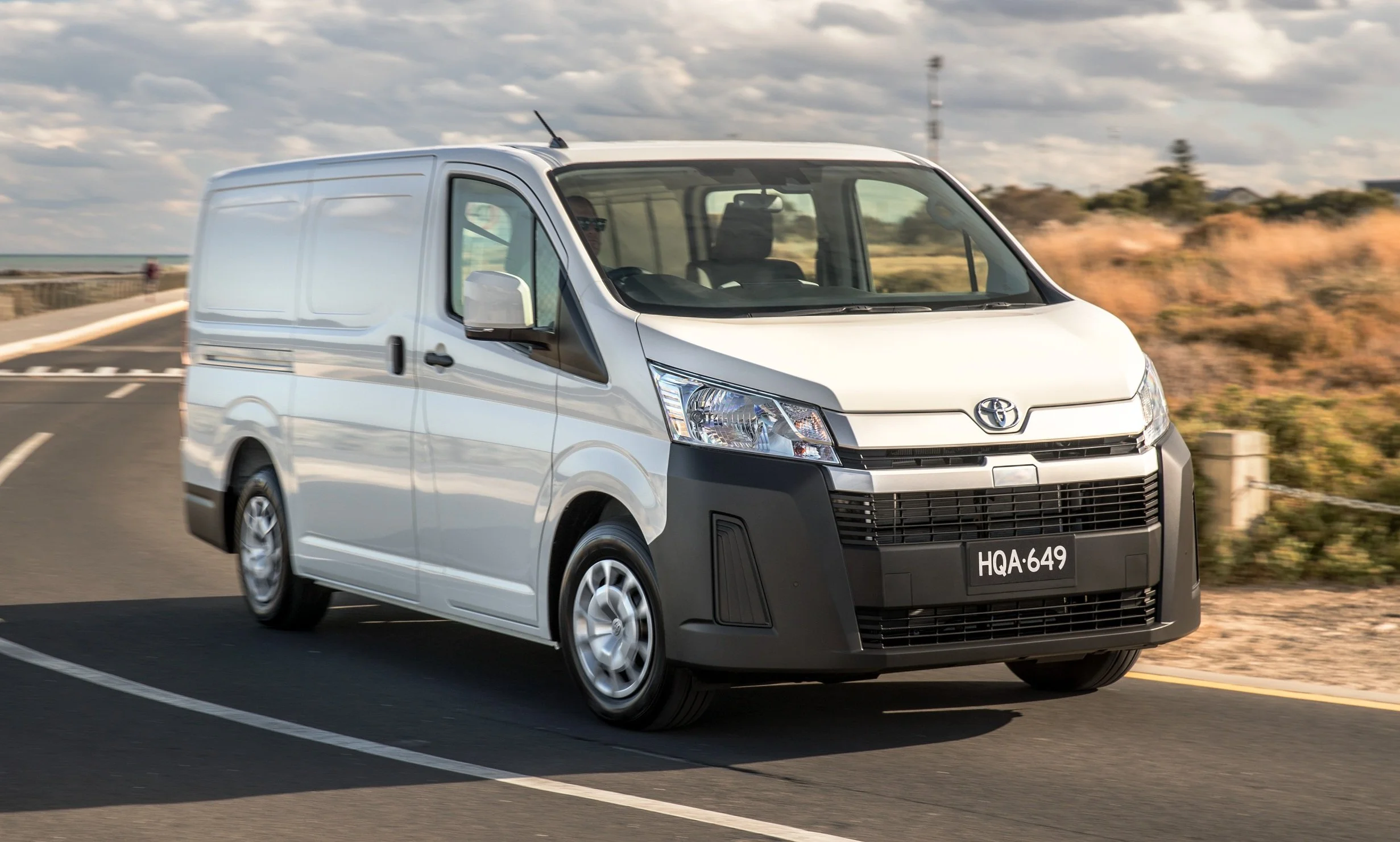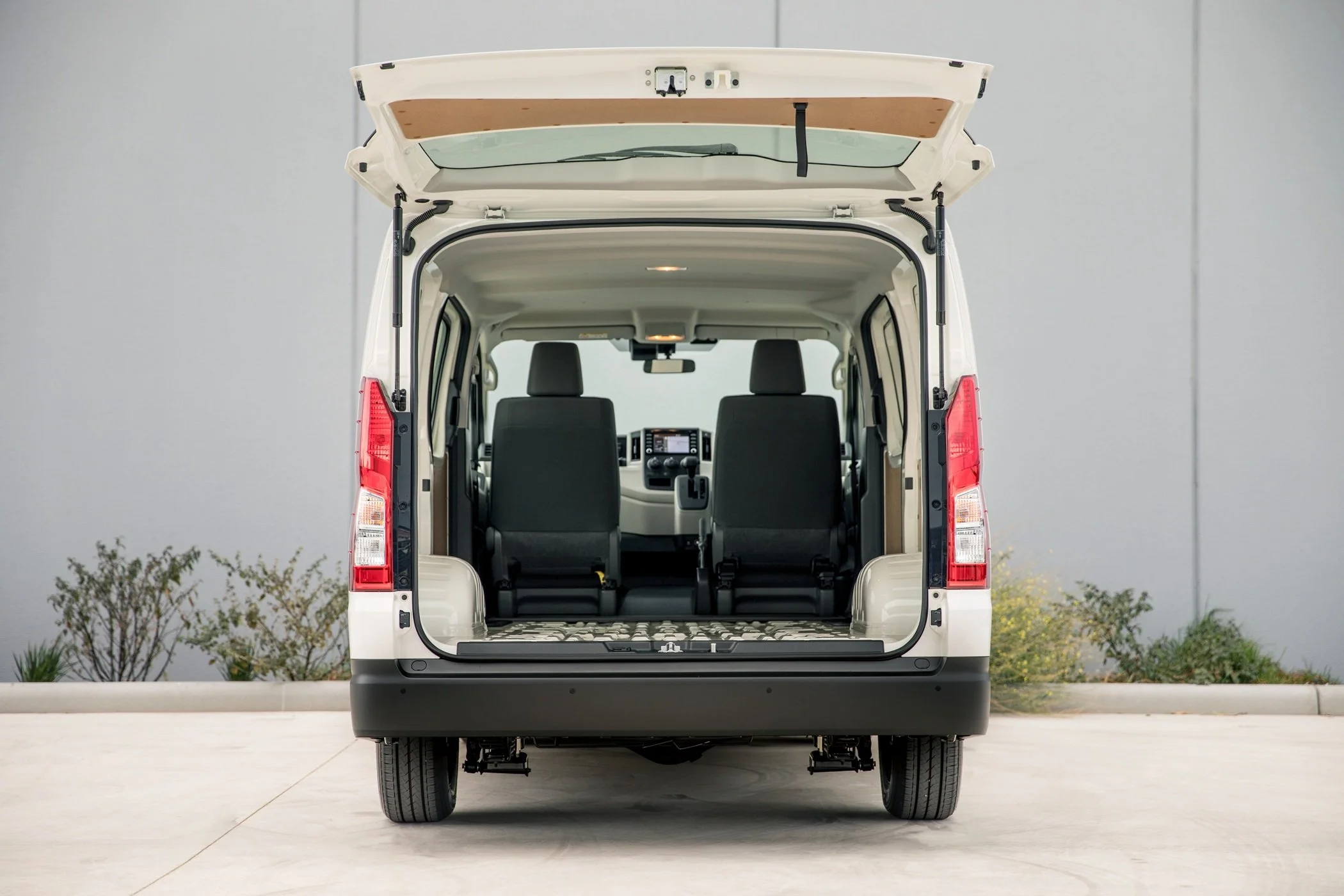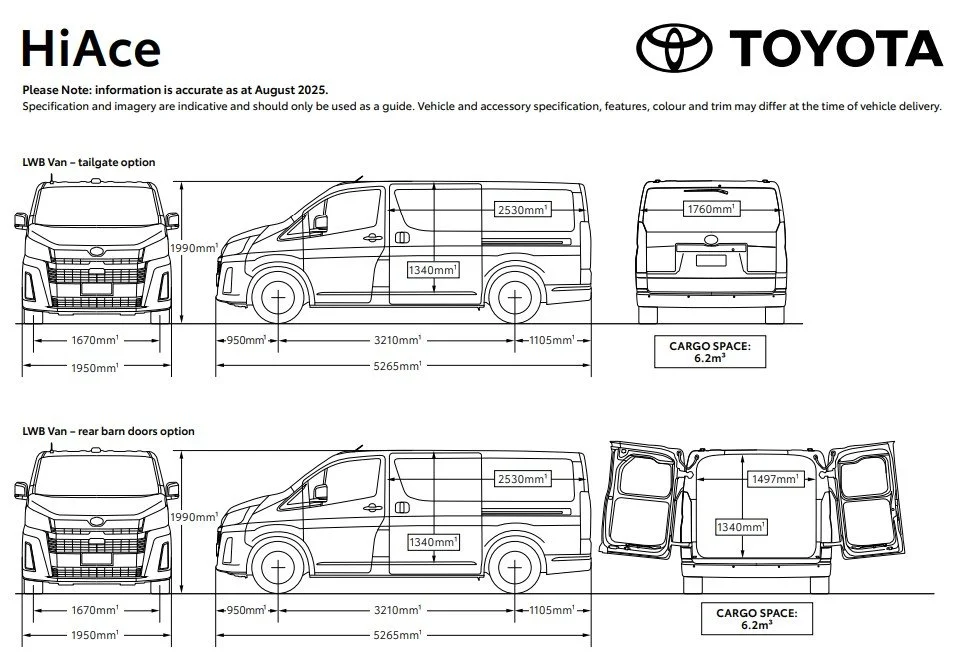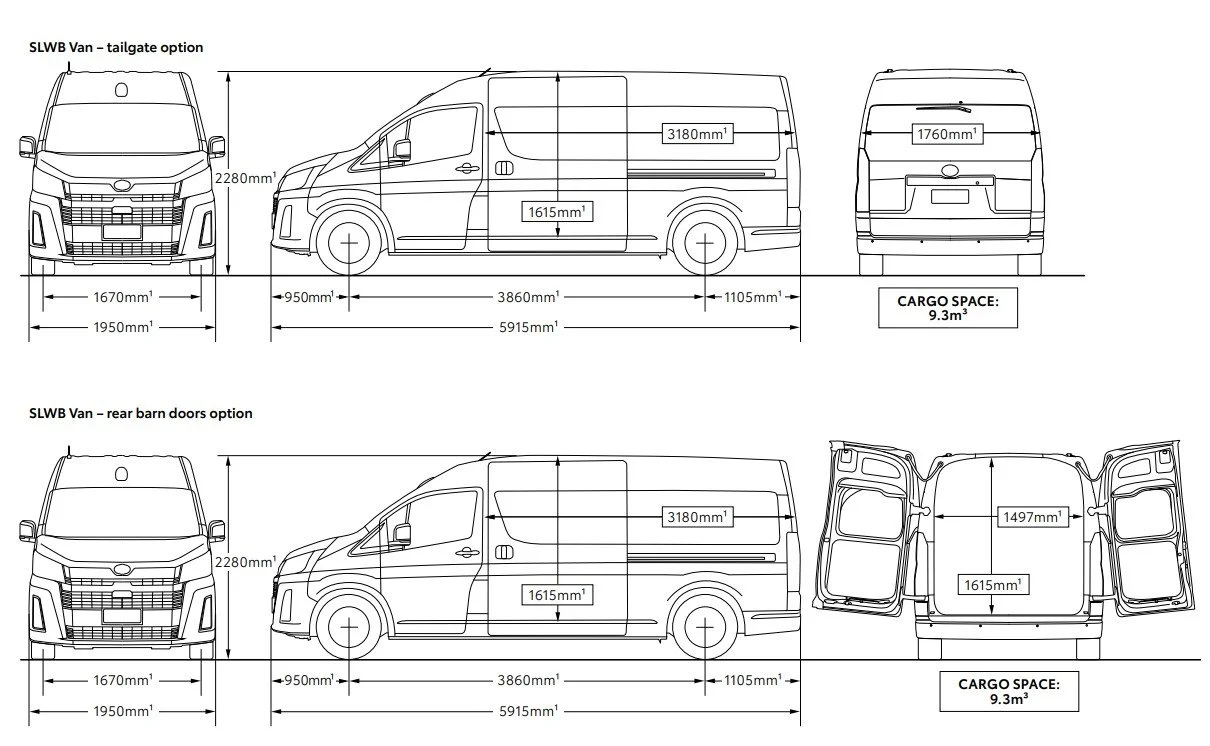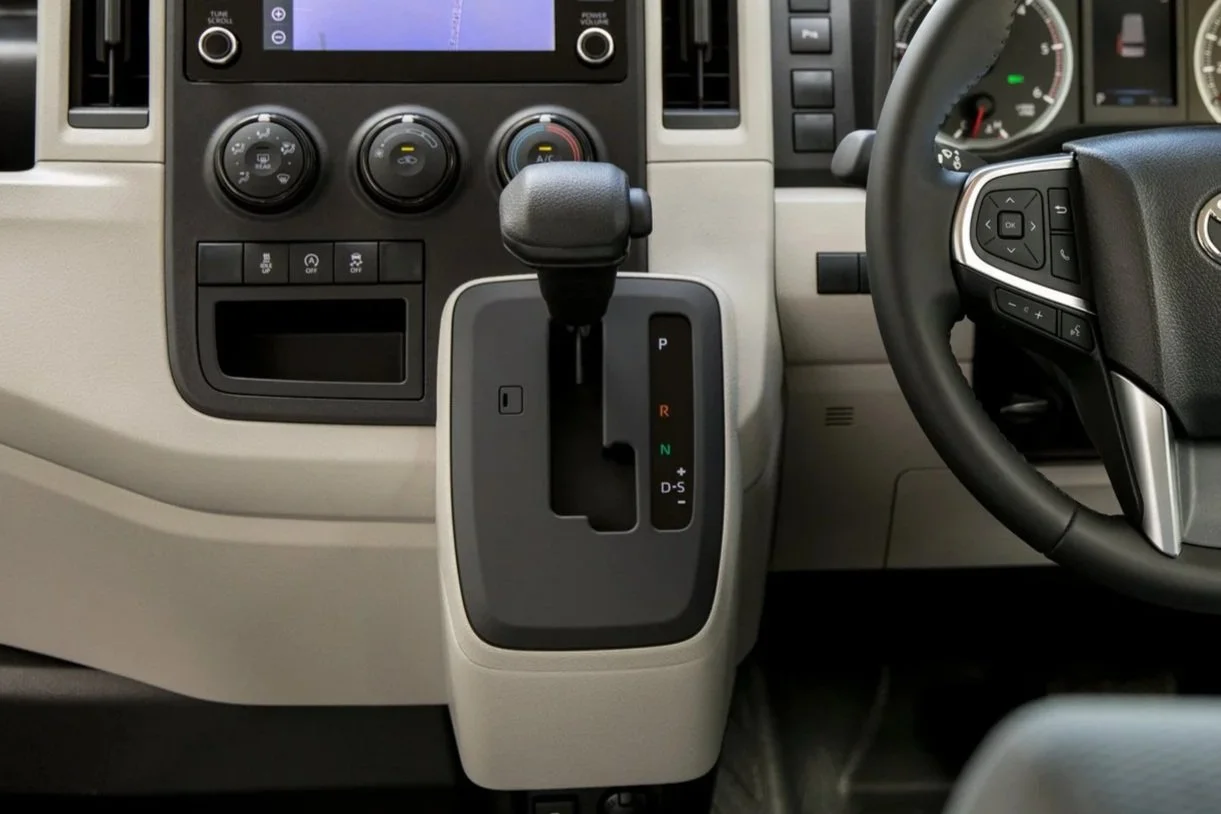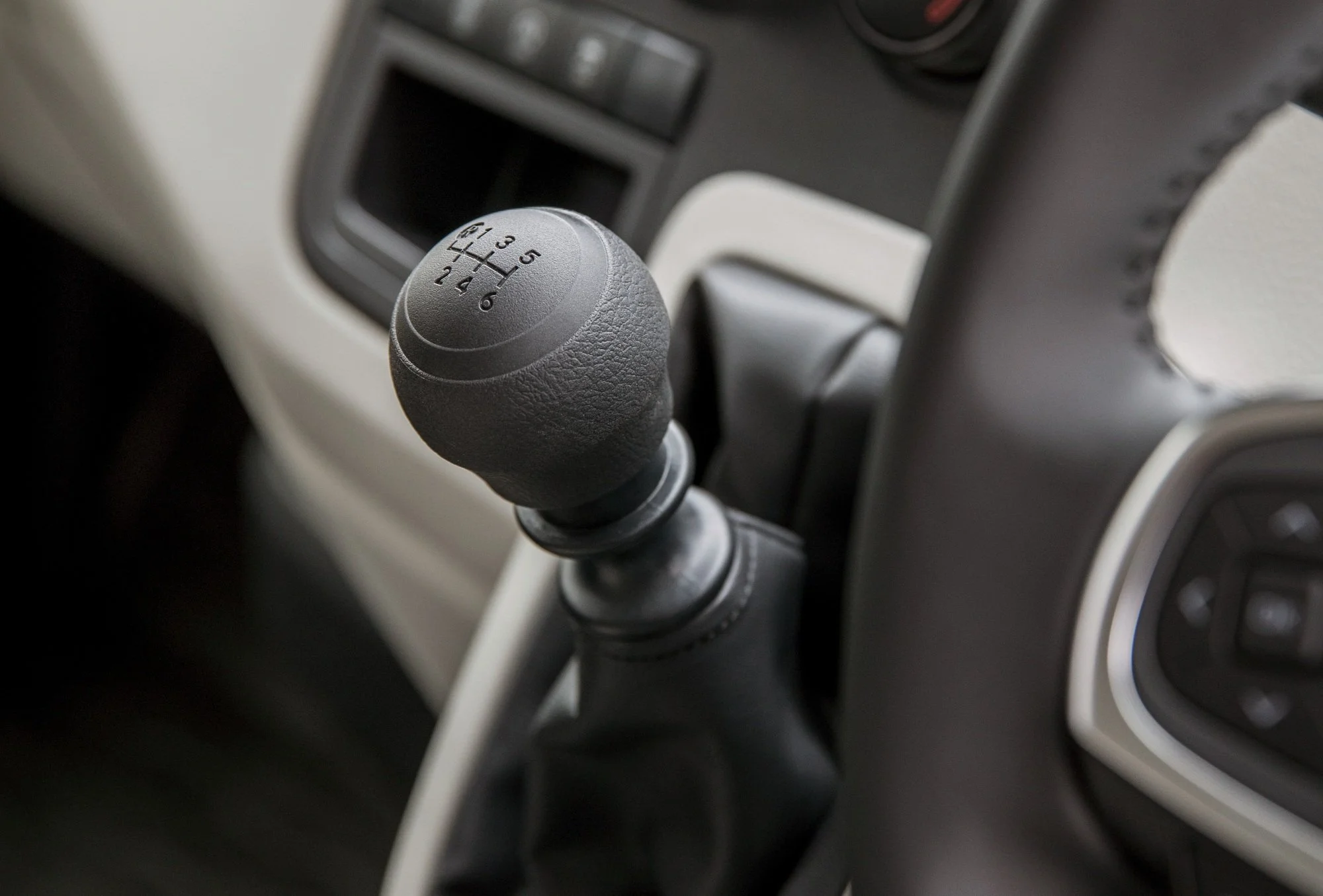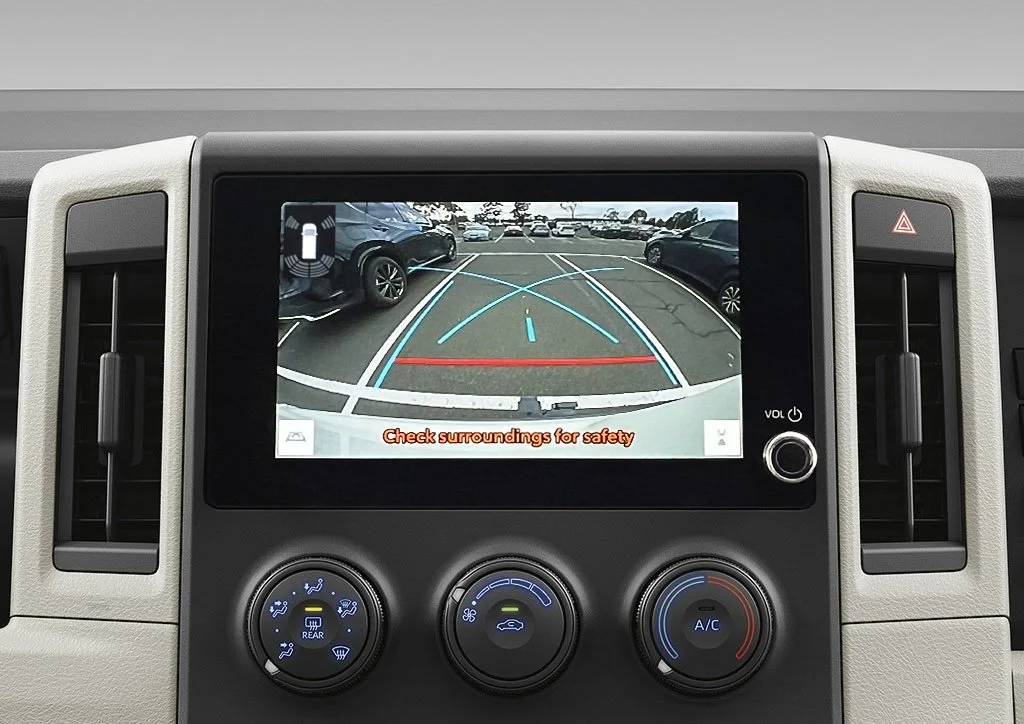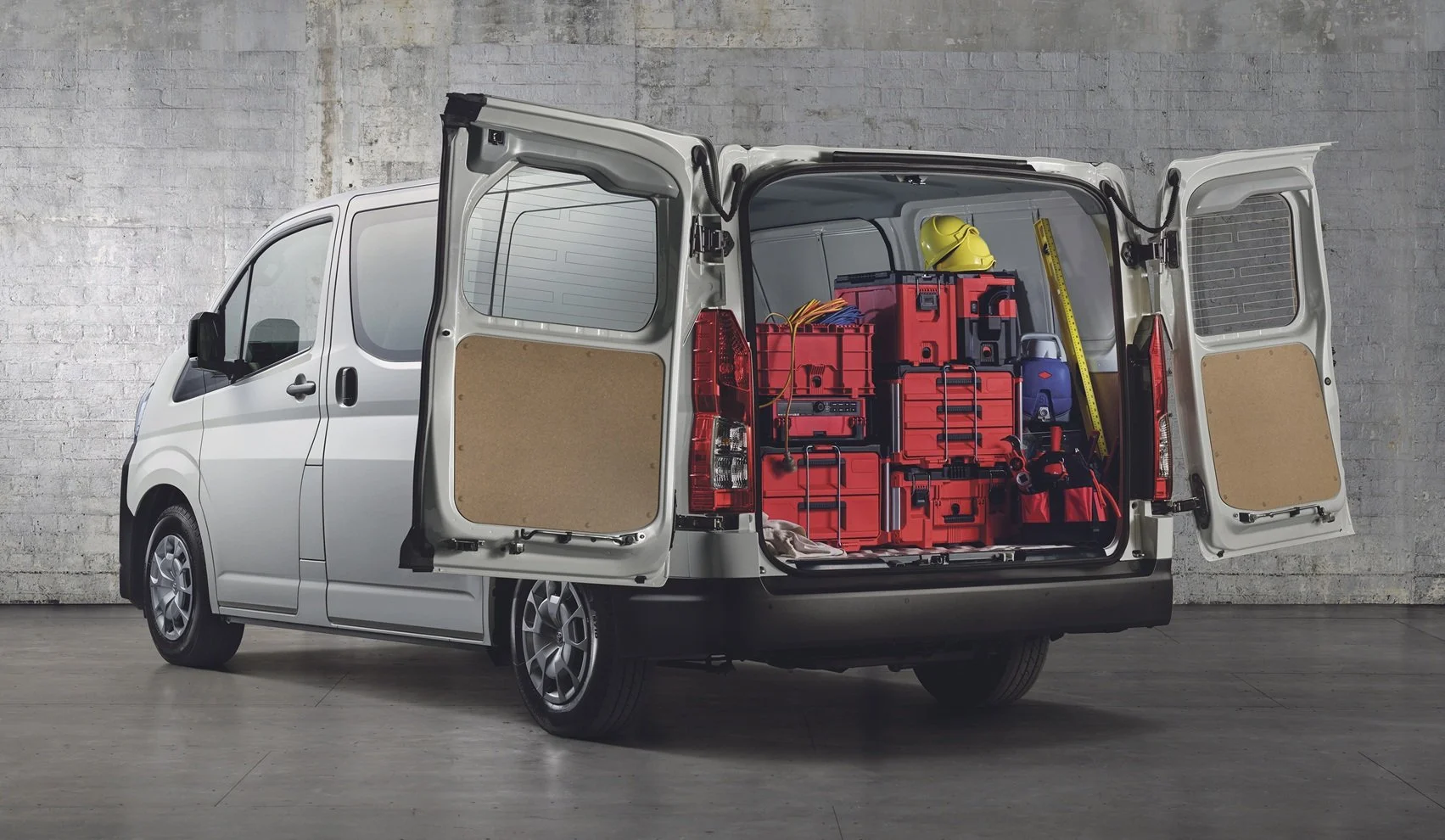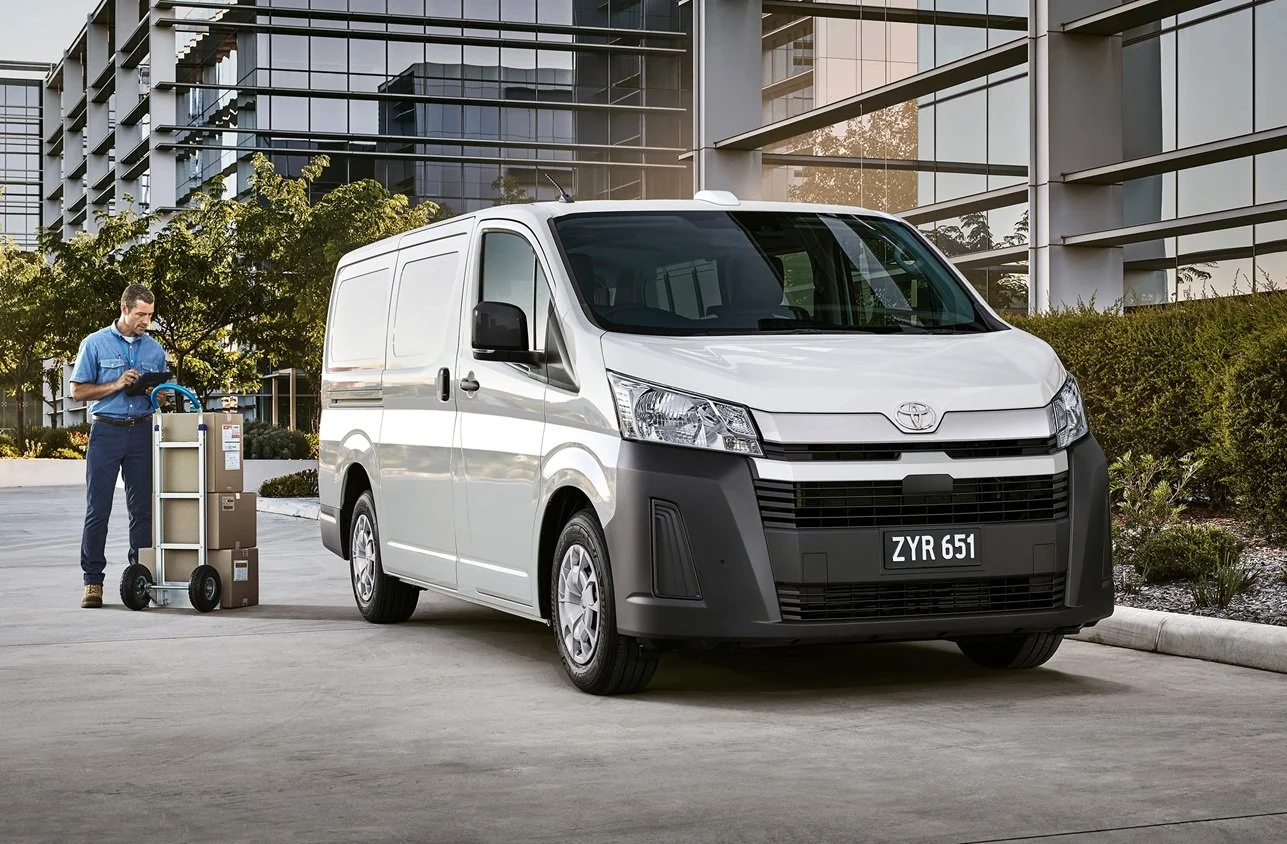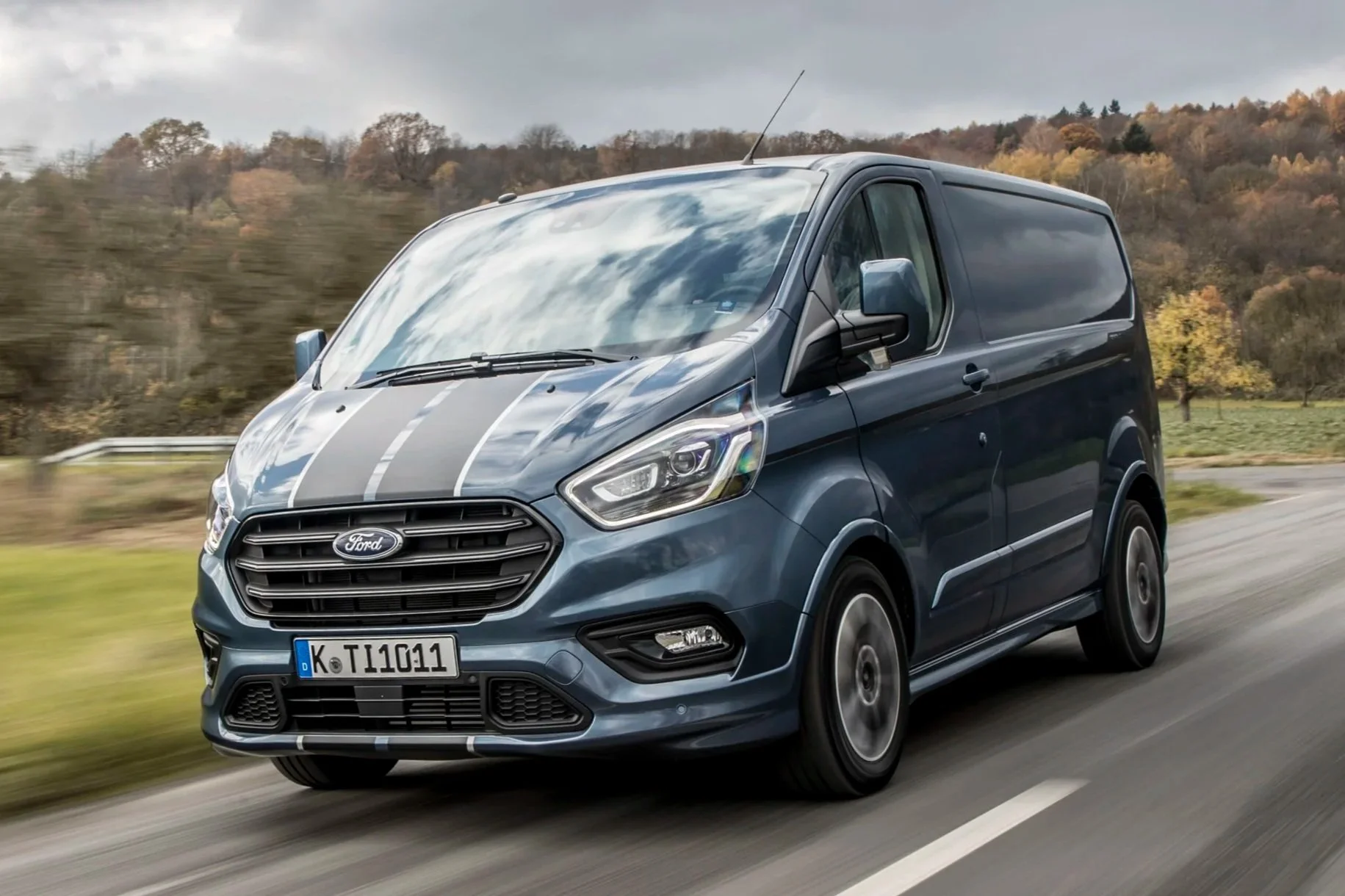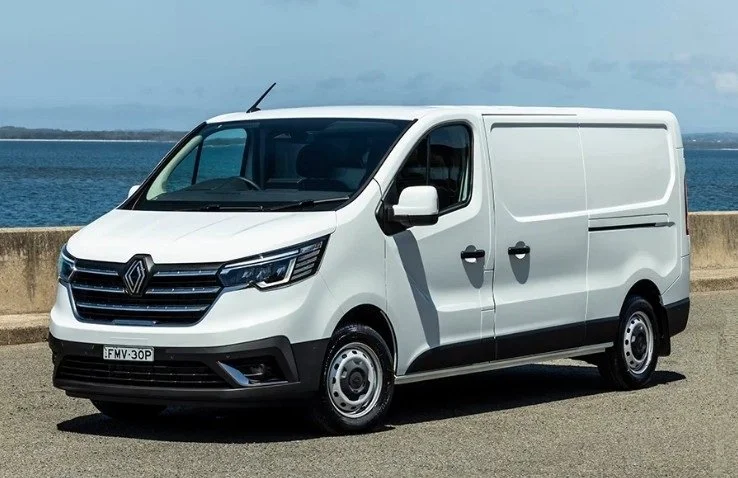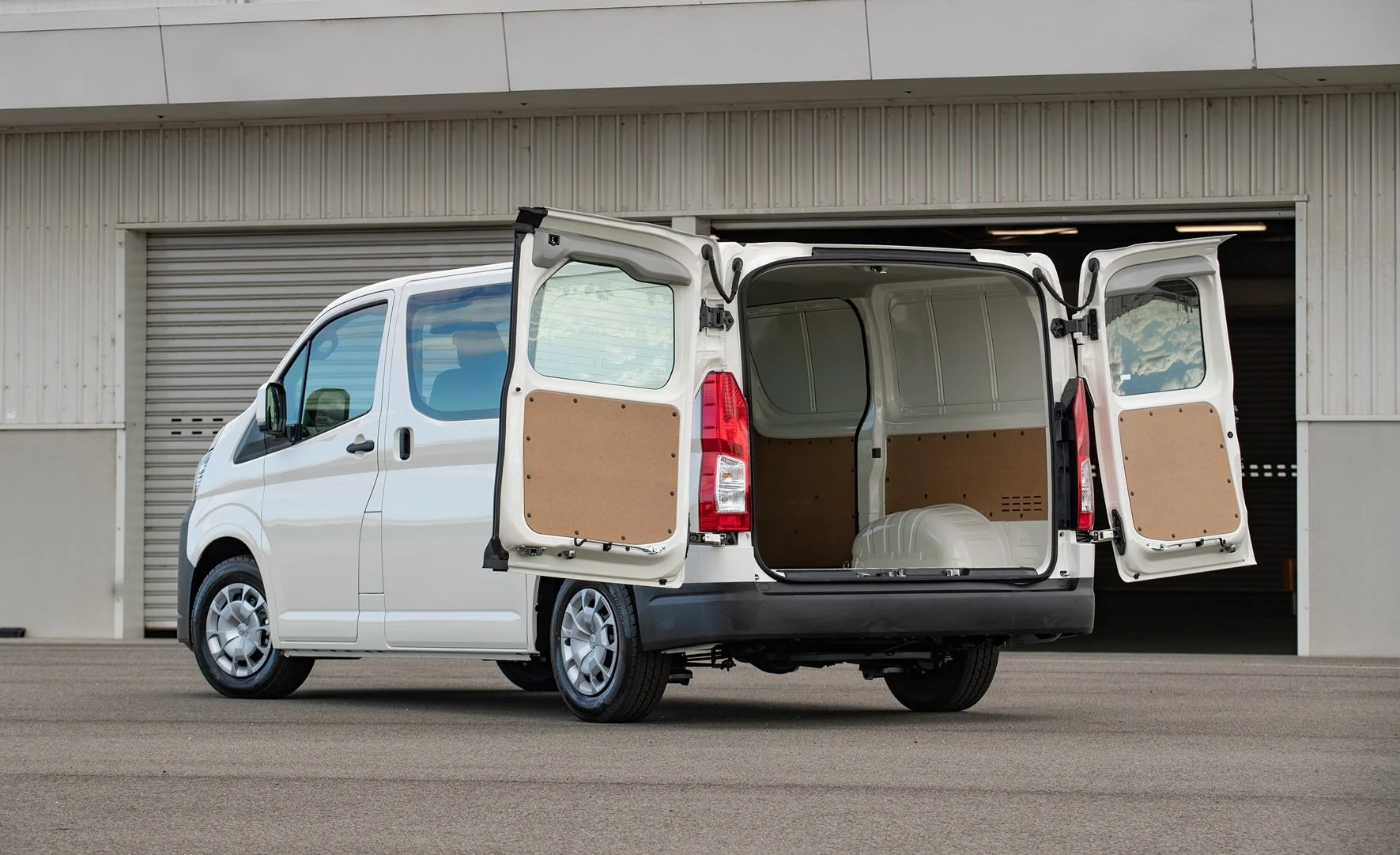Toyota Hiace review and buyer's guide
The Toyota Hiace is generally the first thought when your business needs a new van, or even a fleet of them. But does it still compete on value against rivals from Hyundai, Ford and Renault?
Toyota Hiace is a multi-purpose van platform capable of taking impressive amounts of cargo, carrying decent numbers of passengers in bus form, and has proven reliable daily courier transport for a long time.
But how does it stack up against a flurry of equally functional rivals including Ford Transit, Hyundai Staria-Load, Renault Trafic and budget-conscious options from Chinese brands like LDV Deliver 9 and G10?
Toyota has enjoyed van fleet dominance for a long time and especialyl in recent years with the demise of the Mitsubishi Express which was its nearest rival for 20 years. But the Ford Transit and Renault Trafic offer greater interior comfort, the Hyundai Staria-Load offers better cargo capacity and the LDV options are outrageously well priced.
So let’s see how the Hiace holds up in 2025 and beyond to see if it’s going to suit your particular needs, starting with arguably the Hiace’s greatest strength - resale value. This is also directly related to sales performance, so let’s see how Hiace fairs in market popularity.
According to the VFACTS sales data supplied by the car industry, Hiace is the most popular van by the numbers - without question. Toyota sold over 12,000 Hiaces in 2024 and by the end of September 2025 had managed over 8000 (down over 8 per cent compared with 2024).
The nearest rival on sales is the Ford Transit, but it’s only at around 2500 units in the same period (for a 7 per cent improvement over 2024), meaning for every one Transit Custom, Toyota is selling roughly 6 Hiaces. And Hyundai’s doing no better with Staria-Load, selling 2200 to the end of September 2025, down 8 per cent over 2024.
The LDV G10 is about the only other van punching out reasonable numbers, cracking 1350 units to the end of September 2025, but that’s down over 40 per cent compared with 2024 and moving about 100 G10s per month looks measley compared with the almost 1100 units Toyota moved in the same month.
What this means for you is a solid resale value potential in years to come, meaning there will be residual value in Hiace due to its overwhelming popularity.
A 2021 Toyota Hiace is currently trading at $34,000-$44,000 according to Redbook data, and that’s coming from an original purchse price of $46K. So after three years it’s retained at least 73 per cent of its worth on trade-in.
Compare that with a 2021 Hyundai Staria-Load, you’re looking at trading it for $22,000-$33,000 (again according to Redbook), after purchasing it for about $45,000 brand new. That’s roughly 71 per cent retained value. It’s close, but technically the Hiace wins - but not by much - and if the Staria-Load is the better van (which we’ll get to later) is it really Hiace that’s the superior vehicle?
Let’s look at what you get for the price of a Hiace.
Click here to download the Toyota Hiace spec sheet >>
FEATURES & PRICING
LWB (long wheelbase) | $56,250 (driveaway approx.) manual | $58,300 (driveaway approx.) auto
you get:
16-inch steel wheels with full size spare
Wireless Apple CarPlay and Android Auto with AM/FM/digital radio
Satellite navigation
2 front speakers
8-inch colour touchscreen display
7-inch digital multi-information display
Automatic High Beam (AHB)
Lane Departure Alert (LDA) with Lane Trace Assist
Pre-Collision Safety System with Autonomous Emergency Braking (AEB)
Road Sign Assist
Emergency Driver Support System (EDSS)
Left and right side sliding doors
Reversing camera with front and rear parking sensors
10 SRS airbags (including centre airbag)
Left side sliding door with glass panel
2-seat capacity
Towing capacity: 1900kg (braked, manual transmission) | GCM: 5200kg (manual transmission)
1500kg (unbraked, auto transmission) | GCM: 4800kg (unbraked, auto transmission)
OPTIONAL:
Digital rear view mirror with auto-dimming
Rear barn doors (+$771)
Left side sliding door with steel panel
Body coloured door handles
Body coloured front and rear bumper
SLWB (super long wheelbase) | $67,100 (driveaway approx.) auto
adds:
5-seat capacity
Leather accented steering wheel
Overhead console storage
Digital rear view mirror with auto-dimming
Rear barn doors (optional)
LWB crew (long wheelbase)
10x SRS airbags
Digital rear view mirror with auto-dimming
Rear passenger occupant detection
16-inch steel wheels with full size spare
Wireless Apple CarPlay and Android Auto with AM/FM/digital radio
Satellite navigation
2 front speakers
8-inch colour touchscreen display
7-inch digital multi-information display
Automatic High Beam (AHB)
Lane Departure Alert (LDA) with Lane Trace Assist
Pre-Collision Safety System with Autonomous Emergency Braking (AEB)
Road Sign Assist
Emergency Driver Support System (EDSS)
Left and right side sliding doors
Reversing camera with front and rear parking sensors
10 SRS airbags (including centre airbag)
Left side sliding door with glass panel
5-seat capacity
SLWB Commuter bus (super long wheelbase) adds:
12-seat capacity
4 speakers
8-inch colour touchscreen display
Front and rear air conditioning (duct for every passenger)
Center console tray
3 SRS airbags
Left side sliding door(manual closing)
Pre-Collision Safety System
Lane Departure Alert
Automatic High Beam (AHB)
Road Sign Assist
SLWB Commuter GL bus (super long wheelbase) adds:
Front and rear air conditioning (duct for every passenger)
Left side sliding door(auto closing)
Glass roof escape hatch
FUNCTIONALITY
The LWB variant, which is the most popular version of Hiace, has the following dimensions:
Length: 5265mm | Width 1950mm | Height 1990mm
Wheelbase 3210mm | Front track 1670mm | Rear track 1670mm | Overhang 950mm (Fr), 1105mm (R)
Load length 2530mm | Load width 1760mm | Load height 1340mm | Width b/w wheelarches 1268mm Load volume 6200 L
Turning circle 11 m | Ground clearance 180mm
If you’re likely to do some towing with the LWB, which is entirely reasonable and in many cases a safer option than overloading the Hiace, here are its towing specifications:
Tare mass 2220kg (10L fuel) | Kerb wt. 2205kg (70L fuel) | Gross vehicle mass 3300kg | Payload 1095kg
Towing capacity 1500kg (braked) | Towing capacity (unbraked) 400kg
What’s going to help you to know about the Hiace’s loading capabilities is whether you should spend the extra $770 on the barn door upgrade over the standard awning talgate.
With the barn doors you’re looking at a rear aperture of 1497mm wide and 1340mm high - this is on the standard LWB. On the SLWB those dimensions increase to 1615mm high, but with the same width. So you gain 275mm of clearance by opting for the SLWB and barn doors, which is a 20 per cent gain - good for taller pallets, awkward cargo and makes for better access when restraining.
But it’s interesting to note that your interior cargo volume does not increase with the barn door option, it remains the same at 6.2 cubic metres.
The cargo space according to Toyota’s own measurements is 2530mm x 1340mm x 1760mm, which you then divide by 1,000,000 (yes, one million) to get the result in litres. But the answer is 5.966 cubic metres - that’s 300 metres-cubed shy of Toyota’s official 6.2m3.
Hyundai Staria-Load on the other hand: 2607 x 1640 x 1436 divided by 1 million = 6140 litres. But what Hyundai claims is 4935 litres.
The point here is that Hyundai is underselling the ultimate potential cargo capacity inside its van, whereas Toyota grossly overrepresents the potential space inside the most popular van in Australia.
But rest assured, with 1.26 metres between the wheelarches you can happily fit a standard large Australian pallet, which measures in at 1156mm squared, at least according to Chep Australia. Pro Tip: make sure you load big heavy pallets between the front and rear axles, in the centre of the wheelbase, to minimise axle loads but also to avoid an unbalanced load over the rear cantilevering the front end.
In case you’re buying a van for the first time, you’re going to need a cargo barrier between you (the front seats) and the cargo compartment in the rear three-quarters of the Hiace.
It needs to be a sturdy one that will protect you from sudden stops or crashes where loose objects can become projectiles and hit you or your passenger in the back of the head. If you’re on your 5th Hiace you’ll know this is often thrown in by the dealer when you’re buying three or four vans at once with a fleet discount.
Your cargo area starts from the B-pillar rearward and Hiace has a generous aperture that expands past the wheelarches so a forklift will happily clear the sides. How wide is that aperture?
It’s the widest of the four most popular vans at 1497mm wide if you opt for the barn doors, which are arguably more practical for the sake of only having to open half the rear to get out one small thing and not have your entire cargo empty itself onto the kerb in the pouring rain.
However, Toyota Australia does not state the aperture width with the conventional lift-back tailgate, so presumably it’s exactly the same because there is no design change to accommodate both the set of hinges or gas struts. In fact the top barn door hinge points are the same point where the gas struts fixes to the frame.
Rear access might be an issue getting the 1.4 metre tailgate open because it increases Hiace’s functional, operational length to 6.6 metres. That’s a 25 per cent increase in allowance you need to make when reverse parking to offload packages or equipment.
This might also mean you’re forced to drive forwards into spaces, which in-turn will make you vulnerable to loading/unloading in the thoroughfare of many carparks. On the other hand, that tailgate does make for an excellent temporary awning to somewhat shelter you (and your payload) from the rain.
The other catch-22 you need to figure out when deciding between the barn doors or tailgate is how operationally wide those door make the vehicle.
Note: adding a cargo barrier to your Hiace will reduce the available floor bed length down from the 2530mm Toyota quotes in the diagram above
The barn doors open in a 50/50 split, which makes them roughly as wide as the van itself at 1760mm (keeping in mind the rear is about 190mm narrower than the front; call it 10cm). This means that in their fully open position the doors add 880mm either side of the van.
With both doors open the total width across is now 3.5 metres. Adding another 880mm out the side negates the benefits of having side sliding doors in some respects - but it means you have options depending on what kind of loading situation you’re faced with.
It’s up to you to decide what combination is going to work best for your situation and requirements. And it goes without saying that the same kind of operational logistics pertain to the SLWB version as well. Below are the dimensions, the most pertinent of which is the increased length to 5.91 metres thanks to an extra 650mm in the wheelbase, and not in front or rear overhang - meaning you’ll have the same entry/exit access to ramps, carparks, driveways etc.
But you’ll have to watch that reduced breakover angle from the LWB to the SLWB.
Note: adding a cargo barrier to your Hiace will reduce the available floor bed length down from the 3180mm Toyota quotes in the diagram above
The gross vehicle mass is officially 3300kg in the LWB automatic version, but this varies to 3500kg if you get the SLWB variant.
The kerb weight of the LWB manual transmission is 2225kg, for the auto LWB it’s 2240kg, the LWB Crew version is 2365kg and on the SLWB it’s 2400kg.
The reason it’s important to know these numbers is because they translate specifically into how much payload capacity you have in which to remain compliant. Compliance, of course, being the important bit when it comes to looking at Toyota Australia’s technical specifications only to find there is no quoted payload capacity listed.
But there absolutely is a limit to compliant payload with a Hiace - it’s the law. So let’s figure that out now, and it’s quite simple. You get the Gross Vehicle Mass (GVM) and you take away the kerb weight.
So, on the LWB auto you take the 2240kg kerb wt. from the 3300kg GVM, which equals 1060kg payload. Here are the rest of the Hiace variants done for you:
LWB (manual): 3300kg (GVM) - 2225kg (kerb wt.) = 1075kg payload
LWB (auto): 3300kg (GVM) - 2240kg (kerb wt.) = 1060kg payload
LWB (Crew, auto): 3300kg (GVM) - 2346kg (kerb wt.) = 954kg payload
SLWB (auto): 3500kg (GVM) - 2400kg (kerb wt.) = 1100kg payload
Keep in mind the barn doors add 20kg to the kerb weight, which slightly alters the permissible payload. To make your life easier, here are the same variants with the optional barn doors (where available):
LWB (barn doors, auto): 3300kg (GVM) - 2260kg (kerb wt.) = 1040kg payload
SLWB (barn doors, auto): 3500kg (GVM) - 2420kg (kerb wt.) = 1080kg payload
I'll help you save thousands on a Toyota Hiace
Just fill in this form.
No more car dealership rip-offs.
Greater transparency.
Less stress.
ENGINE
The Hiace is powered by a single 2.8-litre turbo-diesel 4-cylinder engine, the same one we know from the Prado, Hilux and Fortuner for the last 10 years - and the 79 Series LandCruiser ute more recently.
Having fixed their DPF problems about 6 years ago now, the 2.8 has been pretty reliable and proven itself in a number of ways such as in the latest generation 250 Series Prado in extreme off-roading environments, and in the Hilux as a daily tradie workhorse.
In all Hiace body styles, the 2.8 makes 130 kilowatts and 450 Newton-metres of torque, which is plenty for moving its official 1060kg payload capacity.
In fact the power-to-weight ratio of the most popular Hiace variant (the auto LWB) is 59kW per tonne, making it the lowest performing of the four main van model rivals (when compared based on respective kerb weight), behind Renault Trafic on 68kW/t, the Hyundai Staria-Load on 66kW/t and the Ford Transit Custom on 63kW/t.
What’s interesting to know here is that the 2.8 is making it’s peak torque between 1600 and 2400 revs in the auto transmission and 1400-2600 revs in the manual. So clearly the auto is robbing that little bit of low-RPM power; the benefit of the manual being that you get that earlier powerband delivery of the torque which is lasting longer as you get up to speed, which is what you want if you work in hilly areas.
So what you can make of that is: if heavier payloads are going to be common on your typical work week, perhaps consider the gruntier models for keeping up in traffic, or accept the compromise and acknowledge that a slower Hiace is acceptable for how you need it to drive.
Slower doesn’t have to be a negative.
You also get a very decent 70-litre fuel tank, but be aware that this is the same as the Ford Transit Custom and 10 litres less than the Renault Trafic at 80 litres and 5 litres less than Hyundai Staria-Load at 75 litres.
TOWING
Pulling a tool trailer behind your van is remarkably common and important to consider if you have the kind of working requirements that mean you need every tool and regular supplies on the jobsite at all times.
Hiace has very straighforward towing specifications for you to wrap your brain around. The manual LWB Hiace gets a 1900kg braked towing capacity, which drops down to 1500kg on the rest of the auto-transmission variants. (So: LWB, LWB Crew and SLWB.)
As the towball download increases you will need to back off on the payload you add, obviously. But quite unhelpfully Toyota Australia does not publish an official towball download limit for any Hiace model. So you’ll need to be as conservative with your trailer loads as possible.
It might be prudent to keep your towball download to 10 per cent of the braked towing capacity.
TRANSMISSION
The fact Toyota uses only one transmission across the entire range should tell you everything there is to know. The 6-speed epicyclic auto has proven itself very robust and reliable, as well as the manual version on the base LWB Hiace.
Speaking of the manual, you’ll appreciate a nice light clutch pedal for lots of repetitive gear changes .
To the benefit of reduced front tyre wear you’ll appreciate that the Hiace is rear-wheel drive, meaning there’s a tailshaft running to the rear axle. This leaves the fronts doing the steering and the bulk of the braking, and the rears for putting power to the road, making for more even tyre wear.
Although, if you have your vans serviced regularly and on time as required, tyre rotation should be part of that routine maintenance in any front-drive van anyway.
Wheel and tyre combinations remain the same on every Hiace variant, so even if you opt for a mixed fleet for various reasons, wheels and tyres are interchangeable. But try not to use that as an opportunity to mix-n-match; this is more of a get-out-of-jail card in the event of multiple punctures, recovering stranded vehicles or performaing in-house maintenance or whatever.
It’s also worth being conscientious of the driveline on the longer wheelbase variants which uses a single-piece tailshaft rather than some vans that might typically extend the shoter-wheelbase’s shaft by using a two-piece tailshaft with a universal joint.
The benefit here being that this single tailshaft reduces complexity and means one moving part rather than two. It also means less energy is lost transferring the torque from one tailshaft to the next and finally to the differential.
Keep the 6-speed transmission (manual or auto) serviced at the required kilometres or time stipulated by the service schedule and there’s no reason why it shouldn’t last long into the future with little to no issues.
INTERIOR
Hiace has a very basic interior and that means functionality in this department is pretty good - because less is more in the case of hard-working light commercial vans.
The rearview camera is reasonably crisp, clear and generous in its size (8 inches), with the camera mounted in the centre of the tailgate (or on the handle-side of the barn doors if you picked that option.
Robust HVAC dials are clear, within easy reach and free of cluttering irrelevant additional buttons; hazard button is ideally placed for quick activation
In the context of tradie vans, the Hiace is not the most bare-bones interior, and nor is it the pinnacle of modern, stylish or snazzy interiors. It will do the job quite adequately, however, and that’s the name of the game for most people.
‘Good enough’ is going to be exactly that for most buyers - and drivers, of course - offering a range of functional equipment and virtually no garnish or aesthetic considerations. Except, that is, to say it’s not weird or quirky.
There are two bottle holders in the doors with reasonably sized door bins for shoving gloves and snotty tissues, and there are two more cupholders mounted at either end of the dashboard (one above the driver’s right knee and one above the front-passenger’s left knee).
You’ll recognise the 8-inch touchscreen from the previous generation RAV4 and the fact it still has buttons in 2025 - that’s a win for reducing driver distraction unlike the typical driver stalking camera systems you might notice are absent in Hiace. Again, a win for avoiding unwarranted false-positive distractions to you or your drivers.
Rubbber floor mats will remove and wash easily, and cloth seats (at least from Toyota generally speaking) are quite comfortable over most suburban routes and freeways, although don’t go expecting them to come with any modern comforts like heating or cooling.
You do get electrically adjustable lumbar on the driver’s seat of all Hiace model grades, which is good for lower back support after 6 hours on the road.
The electric power steering is typical Toyota ultra light, which is usually a downside in most family vehicles but is a godsend for couriers and tradies who often have to navigate a heavily laden van in tight spaces and make sponteneous 3-point turns.
Being a semi-bonnet stye front end design you no longer have that unerring sense your legs are going to be enmeshed into the front firewall in the event of a crash - unlike the old Hiace where your feet, legs and hips were right in the firing line.
It also means that any fleet manager who has their own team of mechanics working on their vehicles in-house doesn’t need to access the interior to access the engine like the bad old days of Econovans and early iterations of Hiace.
The front-engined layout also means that swapping drivers on a trecharously busy road or during heavy rain doesn’t need to leave the vehicle to swap spots. This is because the low transmission tunnel/floor means you can slide your legs over and avoid being cleaned up at the roadside.
DRAWBACKS
Aside from not knowing the official towball download limit, or why Toyota Australia misrepresents how much internal cargo capacity the Hiace actually offers - there aren’t many issues with this, the most popular van in Australia according to VFACTs sales data.
Having only one lowly USB port in the front is pretty cheap of Toyota Australia when many vans will contain two people, each of whom have a phone they might like to charge on the way to/from work.
It’s also quite tight-arsed of Toyota to only offer manual Hiaces drum brakes on the rear when there are discs all round on the auto transmission variants. Have a gear lever and clutch pedal should make absolutely no difference to the braking system on HIace. This is purely a cost-cutting measure, surely.
What’s worse about the drum brakes is that this is only a light commercial vehicle, expected to be heavily laden all day every day for the rest of its life. Typical of Toyota Australia to live up to their reputation of mediocrity.
Rear drum brakes: nice one, Toyota
MAIN COMPETITORS
What’s important to point out here is that carmakers like to give you the best-looking numbers without making them as drop-dead simple to understand in context.
For payload they want the biggest number, but that might be harder for you to truly compare if they use tare weight (which has only 10 litres of fuel on board) instead of kerb weight (which means with a full tank).
It’s the same story with dimensions, or something very restrictive like towball download limits. So when you don’t see a figure quoted for some aspect of your desired van, go looking for it; and if you can’t find it, that should tell you something. Carmakers know every single piece of data on their vehicles - so why aren’t they sharing that with you? (It’s not always nefarious, but often it can be.)
When it comes to knowing your vehicle inside and out, it’s critical to make sure you’re not overloaded for insurance purposes, keeping your warranty intact, and avoiding any poitential legal ramifications that might be unforseeable.
Here is the basic data on each respective popular van model, based on their entry-level variant. Make sure you corroborate this data for yourself.
Toyota Hiace (LWB)
Engine: 2.8L turbo-diesel | Power: 130kW | Fuel economy (combined cycle): 7.5L per 100km (manual transmission) | 8.4L (auto)
Kerb wt.: 2205kg | Power-weight ratio: 58kW per tonne
Rear door aperture: 1497mm (barn door/tailgate) (W) x 1340mm (H) | Side door aperture: 1497mm (W) x 1615mm (H)
Payload: 1115kg | Braked towing capacity: 1500kg | Rated roof load capacity: Not specified
Hyundai Staria-Load
Engine: 2.2L turbo-diesel | Power: 130kW | Fuel economy (combined cycle): 7L per 100km
Kerb wt.: 1938kg | Power-weight ratio: 67kW per tonne
Rear door aperture: 1300mm (W) x 1320mm (H) | Side door aperture: 870mm (W) x 1320mm (H)
Payload (at kerb weight): 1008kg | Braked towing capacity: 2500kg | Rated roof load capacity: 100kg
Click here for more on Hyundai Staria-Load >>
Ford Transit Custom
Engine: 2L turbo-diesel | Power: 155kW | Fuel economy (combined cycle): 8L per 100km
Kerb wt.: 1889kg | Power-weight ratio: 66kW per tonne
Rear door aperture: 1400mm (W) x 1316mm (H) | Side door aperture: 1030mm (W) x 1301mm (H)
Payload: Trend: 1306kg (SWB), 1336kg (LWB) | Braked towing capacity: 2800kg | Rated roof load capacity: 130kg
Renault Trafic
Engine: 2L turbo-diesel | Power: 125kW | Fuel economy (combined cycle): 6.5L per 100km
Kerb wt.: 1760kg | Power-weight ratio: 71kW per tonne
Rear door aperture: 1391mm (W) x 1320mm (H) | Side door aperture:1030mm (W) x 1284mm (H)
Payload: 1280kg | Braked towing capacity: 2000kg | Rated roof load capacity: 100kg
LDV G10
Engine: 2L turbo-diesel | Power: 118kW | Fuel economy (combined cycle): 8.2L per 100km
Kerb wt.: 2060kg | Power-weight ratio: 57kw per tonne
Rear door aperture: 1370mm (W) x 1179mm (H) | Side door aperture: 820mm (W) x 1165mm (H)
Payload: 1000kg | Braked towing capacity: 1500kg | Rated roof load capacity: 100kg
CONCLUSION
The Toyota Hiace is the best-selling light commercial van in Australia for a bunch of very good reasons, including for its astounding resale value.
But just because it outsells Staria-Load and Transit by 4 to 1, and beats the much cheaper LDV G10 byt 10 to 1, this doesn’t necessarily make it the best van for the job. It just clearly suits a majority of fleets and small business - but not all.
So make sure you research heavily and take a substantive test drive, while also crawling all over the thing - and its conmpetitors. Make sure you connect your phone, try your thermos in the cupholders, and check the roof height is feasible for you and your apprentice.
Make sure the sliding doors get out of the way far back enough for whatever kind of cargo you might need to take, try sliding a pallet in there and locating potential tiedown points - and so on.
Ultimately, the Hiace is pretty slick tool for getting the bulk of Australia’s trade and industrial work done. But don’t buy into it based on the evangelical worship everyone else has for the Hiace. Make an informed choice and guarantee that it’s going to meet your needs.
The good thin about Hiace’s popularity is that even if you get a couple of years into the ownership period and you discover it doesn’t do the job (and something like the Staria-Load or Transit might’ve been the better choice - at least you know there’s always someone else ready to buy your Hiace.

